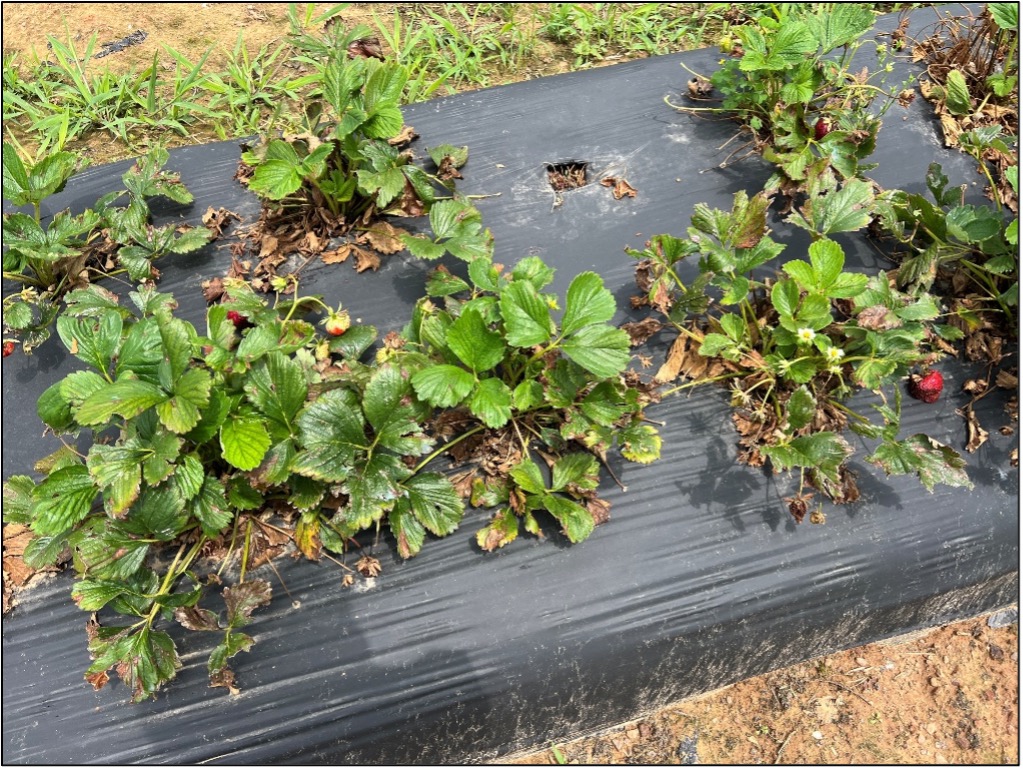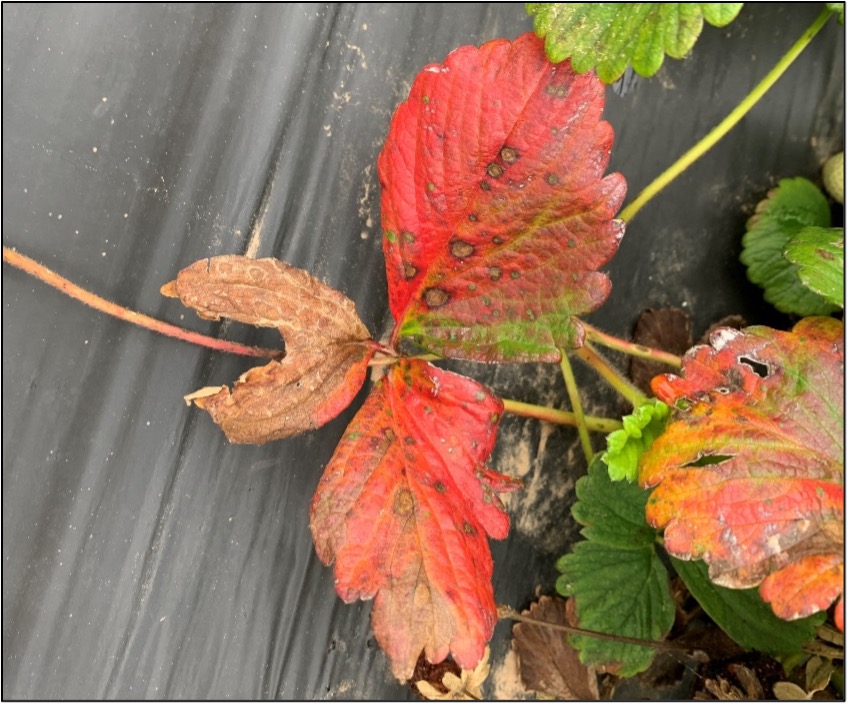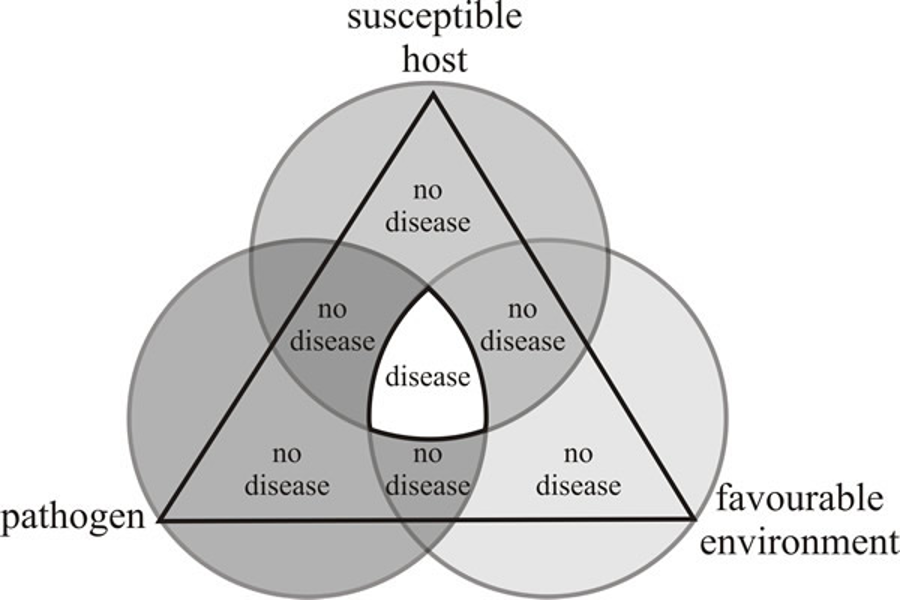
Neopestalotiopsis in Strawberry, aka. Pestalotia leaf spot and fruit rot
Pestalotia fruit rot and leaf spot, caused by Neopestalotiopsis sp. and more commonly referred to as “Neo-P or Neopestalotiopsis”, is an emerging disease that impacts strawberry production (Picture 1). This disease made headlines in 2019 and 2020 when it was first reported to severely impact strawberry production in Florida. We’ve since observed Neopestalotiopsis across the Southeast, including here in Arkansas in 2021 and this last spring. Research has confirmed that this disease is a result of a new species of Neopestalotiopsis not previously described on strawberry. We’ve confirmed this new, aggressive species Neopestalotiopsis to be the causal organism in disease observed in Arkansas strawberries in both 2021 and 2024.

Picture 1. Neopestalotiopsis present on strawberry plants in Northwest, AR in the spring of 2024. These plants were confirmed to be infected with the aggressive species first observed in Florida.
Many growers are on edge going into the 2024-2025 growing season as some strawberry plant suppliers and nurseries across the Southeast are warning growers of issues with Neopestalotiopsis in tip production fields. You can find out more info about what is going on from blog posts made by specialists at the University of Georgia and North Carolina State University. Some nurseries have reported that the observed level of occurrence of Neopestalotiopsis in tips being produced to plugs will probably lead to higher levels of disease, depending on your plug supplier. I would recommend everyone talk to their supplier to get a sense of what risks they specifically may be dealing with coming in on plants this year. We recommend growers talk with suppliers every year regarding anthracnose, phytophthora, and Neopestalotiopsis pressure in nursery plants, and the chatter this year looks to really imply the importance of this practice.
What is Neopestalotiopsis?
Neopestalotiopsis is a new disease caused by a previously undescribed pathogen that is not very well understood. We know that this pathogen attacks leaves, fruit, and the crown of strawberry plants, and can kill plants even before fruit are produced. The development and spread of Neopestalotiopsis is directly related to the amount of pathogen present and environmental conditions, with ideal environmental conditions being the most important factor leading to outbreaks of this disease when pathogen is present. We initially thought hot weather paired with intense rainfall led to Neopestalotiopsis outbreaks, however, more recent findings suggest the optimum temperature for development is 68° F and symptoms can even be observed at 41° F with 48 hours of continuous leaf wetness. In Arkansas, we’ve only really seen this disease after rain events intense and prolonged enough to cause flooding, and in hot periods of the late spring. However, research suggests that conditions that prolong leaf wetness are likely the most important environmental factors that could make disease laden plants lead to economic impact on your bottom line. This factor is why this disease can be difficult to manage in plug production, where tips are often watered for extended periods of time every couple of minutes. Field produced strawberries in Arkansas see several intense rain events each year, especially in the spring when it is 68° F, so we need to do everything we can to suppress the pathogen to avoid disease outbreaks.
Neopestalotiopsis Progression in the Field
Neopestalotiopsis in strawberry is still not very well understood. Plants may come in with leaf spots or look completely green and healthy while being diseased. Healthy plugs planted in the field have been observed to be onset with leaf spot days to weeks after planting, with leaf spots generally appearing on the original transplant leaves. Neopestalotiopsis can survive on plants through our winters until the spring when it warms back up, or it could get into the crown prior to the winter and lead to plant death. When crown infection occurs we normally see a general reddening of older leaves, while new growth will appear yellow and stunted (Picture 2). Most crown rot is observed during fruiting. Send in samples of declining plants determine if Neopestalotiopsis is the culprit, and assume it’s the aggressive species that you are dealing with if it is causing leaf spot, fruit rot, and collapsing plants.

Picture 2. Neopestalotiopsis leaf spot present on strawberry in Northwest, AR. Reddening on leaves is a good indication of crown rot occurring due to this disease.
Researchers in Florida have spent the last 3-4 years assessing the ability of Neopestlotiopsis sp. inoculum to survive in fields after plant termination. Data suggests that the pathogen survives on strawberry plant material and is likely to be present in fields if you go directly back into strawberry only 3-4 months after harvest. In Florida, Georgia, and other areas where crop rotation is not common, lingering disease from year-to-year has been observed. Research from Florida suggests inoculum can survive six months on strawberry leaves before they fully decompose, and up to 15 months on crown plant material still present in the soil. However, data indicate a steady decrease in inoculum levels over time after strawberries were terminated, with only 30% of the initial inoculum being present in crown plant material in the soil 15 months after harvest ceased. Many states are recommending fumigation with Vapam or Piclor 60 when going straight back into a problem area. What this means for us is the risk of reinfection lowers with each year you rotate, and even a year out of the field will have a significant impact on risk. We have yet to observe any fields have issues with Neopestalotiopsis in consecutive years, even when we purposely planted strawberry back into problem areas. This may indicate that large levels of pathogen on plug plants are our main concern, like anthracnose fruit rot and Botrytis fruit rot.
Recommendations for the 2024-2025 Strawberry Season
The big question we keep getting is what we recommend for growers potentially facing larger than normal Neopestalotiopsis inoculum on plug plants. My biggest recommendation is to look at the disease triangle (Picture 3). We know we are growing susceptible cultivars and the environment is likely to be amenable. This indicates the easiest route to success is to do everything we can to suppress the occurrence of the pathogen to prevent disease. The good thing is that experience from other states suggests that there are several pest management tactics that can help suppress Neopestalotiopsis. With that being said, this disease is still not well understood, and we continue to find out new things each year. If you plan to grow strawberries this year your pest management program needs to start ASAP and remain militant until harvest is complete.

Picture 3. Illustration of the disease triangle. All three points of the triangle must be present for a disease to occur. Image by Department of Plant Pathology of the University of Wisconsin-Madison.
Necessary Cultural Control Tactics
- Prioritize disease free transplants as much as possible. Cull all unhealthy plants. Look for leaf spot and reddening of leaves to suggest infection of Neopestalotiopsis. Rogue all trays with a significant portion of dead plants and especially those with prevalent leaf spot. Don’t move healthy plants from diseased trays to save. Do not plant plugs with excessive disease symptoms and expect them to recover. If a large percentage of your plants come in with disease symptoms, do as much sanitation as you can.
- Cultivars appear to vary in susceptibility to Neopestalotiopsis, but not enough is currently known for it to impact your management program. Sweet Charlie, Florida Brilliance, Camino Real, and Ruby June seem to be very susceptible.
- Limit field operations and how much you work plants. When working plants sanitize hands and shoes between fields. Use gloves when possible, and clean and disinfect equipment when moving from field to field, or even after moving from a hot spot.
- Remove and destroy symptomatic plants. We normally see stunted or dying plants hanging around in fields, this is a year where those plants have to go ASAP.
- Do not work plants when wet and maximize leaf drying as much as possible. This means keeping all weeds out of plant holes, not allowing alleyways to grow up, and avoiding overhead irrigation.
- Do not use forced air to dry plants. Plant drying should be passive through maximized airflow.
- Pick and work infested fields and hot spots last. Avoid picking or working plants when leaves are still wet.
- Avoid excessive use of row covers. This increases humidity and temperature around plants, which prolongs leaf wetness and increases the risk of disease.
Incorporate Fungicides that Effectively Suppress Neopestalotiopsis from Day One!
Many fungicides may not be effective in suppressing Neopestalotiopsis. Research out of Florida, and experiences from other regions of the Southeast, suggest that Thiram, Switch, Rhyme, Tilt, and Inspire are effective in suppressing leaf spot and fruit rot associated with Neopestalotiopsis (Table 1). Thiram and Switch are likely to be the best of the bunch, with FRAC Group 3 fungicides, Rhyme, Tilt, and Inspire, also being effective options.
Table 1. Labeled Fungicides for Field Suppression of Neopestalotiopsis in Strawberry.
|
Product |
AI |
FRAC |
Use Rate |
Uses and Notes |
PHI (days) |
|---|---|---|---|---|---|
|
Thiram SC |
thiram |
M03 |
2.5 qts |
5 applications West of Mississippi River, 12 East of Mississippi River |
1 |
|
Switch |
cyprodinil+ fludioxonil |
9+12 |
11-14 oz |
5 apps at 11 oz/A rate |
0 |
|
Rhyme |
flutriafol |
3 |
7 fl oz |
4 apps max |
0 |
|
Tilt |
propiconazole |
3 |
4 fl oz |
3 apps max |
0 |
|
Inspire |
difenoconozole |
3 |
7 fl oz |
4 apps max |
0 |
Thiram can only be used 5 times in a year if you are West of the Mississippi River, which includes all growers in AR. Although this complicates our fall/spring spray schedule, we have enough uses of other products to make it work. Below are considerations for building a schedule to suppress Neopestalotiopsis. I recommend all growers in Arkansas take a proactive approach and assume they will have high pathogen pressure, which will require multiple sprays in the fall, as well as an effective chemistry each week in the spring.
- Read your labels. Omega and chlorothalonil containing products cannot legally be used in field grown strawberries in Arkansas. You cannot use more than 5 applications of Thiram each year (crop) in Arkansas.
- Budget for multiple applications in the fall. Get plants into the ground as quickly as you can and spray them for Neopestalotiopsis ASAP. I’d recommend spraying every 10-14 days from the day you plant until we get into true cold temperatures. This could be 3-4 applications, and I think Thiram is best used at this time as we want to save Switch to also help with anthracnose and Botrytis in the spring. Spray ahead of rains in the fall, and spray again on a 10-day intervals if we are getting heavy, prolonged rains.
- Consider using the 11 oz rate of Switch. At 11 oz you can use 5 applications across your growing season.
- Do not use more than 3 applications of Tilt, or other Propiconazole containing products. Research from Florida indicates that stunting and yield loss may occur when more is used.
- Inspire may not be available for you. Any application of Inspire Super will use up one of your uses of Switch. Both products contain cyprodinil and using 4-5 applications of Switch reaches the yearly allowance of cyprodinil, per the label. Miravis Prime contains fludioxinil and any application of Miravis Prime is one less application of Switch.
- Use a high sprayer output, minimum of 80-100 Gallons Per Acre (GPA). Experience in Georgia suggests Neopestalotiopsis causing spores may reside deep in the crown on new leaf material. Sprays with low volumes of water, or those that aim to spray several rows at once with air blast sprayers, are unlikely to completely penetrate strawberry plant material. Consider a higher output nozzle pointed directly at crowns on hoop sprayers with several nozzles.
Table 2. Example Spray Schedule for Growers West of the Mississippi River.*
|
App # |
Fungicide |
FRAC Groups |
|---|---|---|
|
Fall 1 |
Thiram |
M03 |
|
Fall 2 |
Thiram |
M03 |
|
Fall 3 |
Thiram |
M03 |
|
Fall 4? |
Thiram |
M03 |
|
Spring 1 |
Switch |
12 + 9 |
|
Spring 2 |
Captan + Elevate + Rhyme |
M04 + 17 + 3 |
|
Spring 3 |
Switch + Captan |
12 + 9 + M04 |
|
Spring 4 |
Captan + Elevate + Rhyme |
M04 + 17 + 3 |
|
Spring 5 |
Luna Sensation + Thiram |
7 + 11 + M03 |
|
Spring 6 |
Switch + Captan |
12 + 9 + M04 |
|
Spring 7 |
Luna Sensation + Captan + Tilt |
7 + 11 + M04 + 3 |
|
Spring 8 |
Switch + Captan |
12 + 9 + M04 |
|
Spring 9 |
Luna Sensation + Captan + Rhyme |
7 + 11 + M04 + 3 |
|
Spring 10 |
Switch + Captan |
12 + 9 + M04 |
|
Spring 11 |
Cabrio + Captan + Tilt |
11 + M04 + 3 |
*This is only a suggested spray schedule. Many equivalent products exist that can take the place of those suggested here. The label is the law, read the label to avoid incorrect usage of any pesticide product. Rotate FRAC groups between each spray to avoid resistance.
Table 3. Example Spray Schedule for Growers East of the Mississippi River.*
|
App # |
Fungicide |
FRAC Groups |
|---|---|---|
|
Fall 1 |
Thiram |
M03 |
|
Fall 2 |
Thiram |
M03 |
|
Fall 3 |
Thiram |
M03 |
|
Fall 4? |
Thiram |
M03 |
|
Spring 1 |
Thiram + Switch |
M03 + 12 + 9 |
|
Spring 2 |
Captan + Elevate + Rhyme |
M04 + 17 + 3 |
|
Spring 3 |
Switch + Thiram |
12 + 9 + M03 |
|
Spring 4 |
Captan + Elevate + Tilt |
M04 + 17 + 3 |
|
Spring 5 |
Luna Sensation + Thiram |
7 + 11 + M03 |
|
Spring 6 |
Switch + Thiram |
12 + 9 + M03 |
|
Spring 7 |
Luna Sensation + Captan + Tilt |
7 + 11 + M04 + 3 |
|
Spring 8 |
Switch + Thiram |
12 + 9 + M03 |
|
Spring 9 |
Luna Sensation + Thiram + Rhyme |
7 + 11 + M03 + 3 |
|
Spring 10 |
Switch + Thiram |
12 + 9 + M03 |
|
Spring 11 |
Cabrio + Thiram + Tilt |
11 + M03 + 3 |
*This is only a suggested spray schedule. Many equivalent products exist that can take the place of those suggested here. The label is the law, read the label to avoid incorrect usage of any pesticide product. Rotate FRAC groups between each spray to avoid resistance.
How Can You be Successful with Strawberries this Year
My role as an extension specialist is to help you succeed in the risks you take. Strawberry growers are no stranger to risk and every year seems to be another curve ball, although this one appears to be moving faster like a slider. Give me a call anytime if you have questions or shoot me an email or text with pictures of plants, sprayers, beds, insects, etc. you want an opinion on. Talk with your plant supplier, get a handle on what is about to show up on the truck and whether to expect potential issues. Get your hands on Thiram, Switch, Rhyme, and Tilt ASAP. Practice extreme sanitation and be picky when putting plants in the field and choosing where to put them. Don’t mix dying with healthy plants and don’t plant anything you feel won’t make it. You may have to deal with a little leaf spot but it’s better if everything going in the field is green. Practice cleaning shoes, hands, and equipment often when moving between fields, avoid moving from diseased to healthy fields, and don’t work plants when they are wet. Fully integrate Thiram, Switch, Rhyme, and Tilt into your schedule, and be sure to spray every 10-14 days in the fall ASAP after planting. When combined this integrated approach will give you the best shot at success.
Aaron Cato
479-249-7352
acato@uada.edu